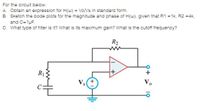
Introductory Circuit Analysis (13th Edition)
13th Edition
ISBN: 9780133923605
Author: Robert L. Boylestad
Publisher: PEARSON
expand_more
expand_more
format_list_bulleted
Question
thumb_up100%
Please && thank you! Please use "jw" notation if possible as that is easier for me to understand, for now.

Transcribed Image Text:### Transcription and Explanation for Educational Website
**Problem Statement:**
**For the circuit below:**
**A.** Obtain an expression for \( H(\omega) = \frac{V_o}{V_s} \) in standard form.
**B.** Sketch the bode plots for the magnitude and phase of \( H(\omega) \), given that \( R1 = 1k\Omega \), \( R2 = 4k\Omega \), and \( C = 1\mu F \).
**C.** What type of filter is it? What is its maximum gain? What is the cutoff frequency?
**Circuit Diagram Description:**
The circuit consists of an operational amplifier in a feedback configuration. The input voltage \( V_s \) is applied across a resistor \( R1 \) and a capacitor \( C \) in series. The feedback resistor \( R2 \) connects the output voltage \( V_o \) to the inverting input of the op-amp. The non-inverting input of the op-amp is grounded.
**Explanation of Components:**
- \( R1 \): A resistor with a resistance of \( 1k\Omega \).
- \( R2 \): A feedback resistor with a resistance of \( 4k\Omega \).
- \( C \): A capacitor with a capacitance of \( 1\mu F \).
**Analysis:**
1. **Expression for \( H(\omega) \):**
The expression for the transfer function \( H(\omega) \), which is the ratio of the output voltage \( V_o \) to the input voltage \( V_s \), needs to be derived based on the circuit's configuration.
2. **Bode Plots:**
Bode plots are graphical representations that show how the gain (magnitude) and phase of the transfer function \( H(\omega) \) vary with frequency. The task involves sketching these plots for the given component values.
3. **Filter Type, Maximum Gain, and Cutoff Frequency:**
- **Filter Type:** Determine the type of filter (e.g., low-pass, high-pass, band-pass, or band-stop).
- **Maximum Gain:** Identify the maximum amplification provided by the filter.
- **Cutoff Frequency:** Calculate the frequency at which the filter's gain drops by 3 dB from its maximum value.
This circuit requires an understanding of operational amplifier behavior, frequency response analysis
Expert Solution
This question has been solved!
Explore an expertly crafted, step-by-step solution for a thorough understanding of key concepts.
This is a popular solution
Trending nowThis is a popular solution!
Step by stepSolved in 6 steps with 6 images

Knowledge Booster
Learn more about
Need a deep-dive on the concept behind this application? Look no further. Learn more about this topic, electrical-engineering and related others by exploring similar questions and additional content below.Similar questions
- Look at picture 2. Determine the Truth Table for the following Boolean equation: (Note the placement of the inversion bars. This is NOT the Boolean expression for a NOR gate.) A B X 0 0 0 1 1 0 1 1arrow_forwardQuestion No. 4 Convert following numbers to binary numbers i. (784)10 ii. 78Aarrow_forwardSolve correct pleasearrow_forward
arrow_back_ios
arrow_forward_ios
Recommended textbooks for you
 Introductory Circuit Analysis (13th Edition)Electrical EngineeringISBN:9780133923605Author:Robert L. BoylestadPublisher:PEARSON
Introductory Circuit Analysis (13th Edition)Electrical EngineeringISBN:9780133923605Author:Robert L. BoylestadPublisher:PEARSON Delmar's Standard Textbook Of ElectricityElectrical EngineeringISBN:9781337900348Author:Stephen L. HermanPublisher:Cengage Learning
Delmar's Standard Textbook Of ElectricityElectrical EngineeringISBN:9781337900348Author:Stephen L. HermanPublisher:Cengage Learning Programmable Logic ControllersElectrical EngineeringISBN:9780073373843Author:Frank D. PetruzellaPublisher:McGraw-Hill Education
Programmable Logic ControllersElectrical EngineeringISBN:9780073373843Author:Frank D. PetruzellaPublisher:McGraw-Hill Education Fundamentals of Electric CircuitsElectrical EngineeringISBN:9780078028229Author:Charles K Alexander, Matthew SadikuPublisher:McGraw-Hill Education
Fundamentals of Electric CircuitsElectrical EngineeringISBN:9780078028229Author:Charles K Alexander, Matthew SadikuPublisher:McGraw-Hill Education Electric Circuits. (11th Edition)Electrical EngineeringISBN:9780134746968Author:James W. Nilsson, Susan RiedelPublisher:PEARSON
Electric Circuits. (11th Edition)Electrical EngineeringISBN:9780134746968Author:James W. Nilsson, Susan RiedelPublisher:PEARSON Engineering ElectromagneticsElectrical EngineeringISBN:9780078028151Author:Hayt, William H. (william Hart), Jr, BUCK, John A.Publisher:Mcgraw-hill Education,
Engineering ElectromagneticsElectrical EngineeringISBN:9780078028151Author:Hayt, William H. (william Hart), Jr, BUCK, John A.Publisher:Mcgraw-hill Education,

Introductory Circuit Analysis (13th Edition)
Electrical Engineering
ISBN:9780133923605
Author:Robert L. Boylestad
Publisher:PEARSON

Delmar's Standard Textbook Of Electricity
Electrical Engineering
ISBN:9781337900348
Author:Stephen L. Herman
Publisher:Cengage Learning

Programmable Logic Controllers
Electrical Engineering
ISBN:9780073373843
Author:Frank D. Petruzella
Publisher:McGraw-Hill Education

Fundamentals of Electric Circuits
Electrical Engineering
ISBN:9780078028229
Author:Charles K Alexander, Matthew Sadiku
Publisher:McGraw-Hill Education

Electric Circuits. (11th Edition)
Electrical Engineering
ISBN:9780134746968
Author:James W. Nilsson, Susan Riedel
Publisher:PEARSON

Engineering Electromagnetics
Electrical Engineering
ISBN:9780078028151
Author:Hayt, William H. (william Hart), Jr, BUCK, John A.
Publisher:Mcgraw-hill Education,